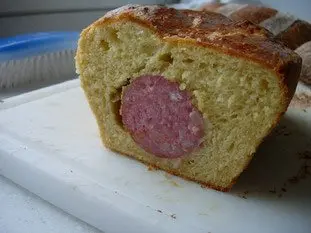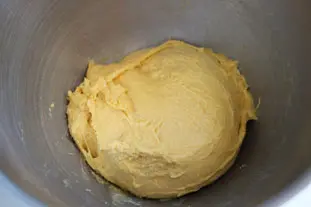This site uses only a few technical cookies necessary for its operation. By continuing to browse, you accept their use.
To find out more...
To find out more...
Brioche for a savoury recipe

When we make brioche, it is generally sweet, that is to say that in the dough there is sugar or honey or dried or candied fruits, or even sometimes the 3 together.
It's normal, it's very good, it's a pastry.
But you may also need brioche for a savoury dish, like a sausage or a sausage in brioche for example.
It's normal, it's very good, it's a pastry.
But you may also need brioche for a savoury dish, like a sausage or a sausage in brioche for example.
13 K 4.9/5 (16 reviews)
Keywords for this post:BriochePastryBakerySugarSaltTipLast modified on: June 30th 2019
Brioche for a savoury recipe

Of course, if you like sweet and savory dishes, you're probably thinking "Yes, but so what?" No problem, we take classic brioche dough (sweetened, that is) and form the brioche that will hold the sausage. The salty flavour of the sausage goes very well with the sweetness of the brioche. D'accord.
On the other hand, if you don't like the sweet-savory side, like me for example, you're not going to like it too much: OK, the softness of the brioche is there, but the honey-sugar side, with the sausage, well...

Well, the best thing to do in this case would be to make brioche dough without sugar, to get a sort of salty brioche, more in keeping with the sausage.
It's tempting, but it would be a mistake, because without sugar the brioche still puffs up, but less well, and above all it doesn't color, despite the gilding.
In other words, you'll end up with a whitish brioche, not bad either, but not very appetizing.
So what do you do?
You have to cut the pear in 2 and put "half-sugar", i.e. you look at the amount of sugar your recipe calls for, imagine 100 gr, you divide this weight by 2 and it's only these 50 gr that you'll use in your recipe. In this way, your brioche will puff up and turn golden, but its taste will be in keeping with the savoury part of your recipe, the sugar being almost "invisible".
In short: For a brioche recipe in a savoury dish, divide the initial weight of sugar by 2.
Lasts posts
Butter vs. grease
We often read in a recipe where a pastry is put into a mould that, just before pouring, the mould should be buttered or greased. But what's the difference between these 2 terms?December 1st 20251,0005
Getting out of the fridge early
Very often when you're cooking, you need to take food or preparations out of the fridge, to use them in the recipe in progress. There's nothing tricky about this: you just take them out of the fridge and use them, usually immediately, in the recipe. But is this really a good method?November 24th 20251,1305
Who's making the croissants?
When you look at a bakery from the outside, you naturally think that in the bakery, the bakers make the bread, and in the laboratory, the pastry chefs make the cakes. It's very often like that, with each of these professions having quite different ways of working, but sometimes there's also one...November 23th 20251,021
Oven height
When we put a dish or cake in the oven, we naturally tend to put it on the middle shelf, and that's what we usually do. But in some cases, this position and height can be a little tricky, so let's find out why.October 8th 20252,7695
The importance of sieving
In recipes that use a fine powder (flour, powdered sugar, etc.), you'll often see the advice to sift before using it. To sift is to pass the powder in question through a sieve (a very fine strainer) before incorporating it into your recipe. It's often advice, but is it really useful?September 3rd 20257,5383
Other pages you may also like
Butter doesn't make you fat, unless you eat too much of it.
Whenever I'm discussing cooking and recipes, there is one idea which comes up frequently, like this: "Oh no! But that's got butter in it" (I should add, for the sake of accuracy, that this is something I hear more frequently from women, who are almost all concerned with keeping their figure). ...March 26th 201245 K4.5
The art of the charlotte
In cooking, a charlotte is a delicious moulded dessert, with biscuits around the outside that have been soaked in a flavoured syrup, filled with a light cream or mousse. The charlotte is left to set in the fridge before being turned out and served in slices. It is very light and a lovely sweet...February 27th 201346 K4.3
Candied fruits: don't get ripped off
Do you like candied fruit? You might like to nibble a handful or add it to a recipe, like a classic fruit cake or delicious Italian specialities like panettone or sicilian epiphany pie.June 21th 201767 K 24.2
Drawing a pattern in pastry
Often in the kitchen, in pastry-making, or in baking, we need to trace a pattern on a pastry. It's just a question of aesthetics but it has its effect after baking on a galette, pithiviers, pâté en croute (terrine in a pie crust), etc.May 23th 201935 K4.1
Stand mixer tools
Whether we call it a stand mixer, food processor, or simply refer to it by brand (Kenwood, KitchenAid, etc.), this machine is a valuable tool for amateur cooks, bakers or pastry chefs like ourselves. All these machines come supplied with 3 different tools. Let’s take a look at their names and...November 2nd 201938 K4.5
Post a comment or question
Follow this page
If you are interested in this page, you can "follow" it, by entering your email address here. You will then receive a notification immediately each time the page is modified or a new comment is added. Please note that you will need to confirm this following.
Note: We'll never share your e-mail address with anyone else.
Alternatively: you can subscribe to the mailing list of cooling-ez.com , you will receive a e-mail for each new recipe published on the site.









